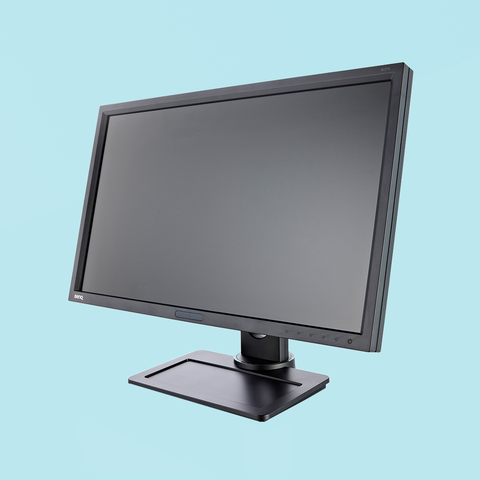Whether you’re working on a laptop or sitting in front of a monitor at work, it’s likely that your computer screen is going to get a bit germy. For most, dust is a major concern — it can silently coat a computer’s screen or a monitor and disrupt the screen’s colors or brightness. You might also have to fight oily fingerprints. Others might be worried about viruses and bacteria during flu season — especially as most can potentially live on surfaces for several days, including the novel coronavirus, which is why the Centers for Disease Control and Prevention is recommending that people disinfect “high touch surfaces” when possible. But cleaning the screen is more delicate than wiping down the rest of your laptop; some cleaners can be abrasive, and using too much liquid could cause your laptop and monitor to short altogether. And yet, unlike other electronics, a glass screen or LCD monitor can attract pesky streaks easily (just like stainless steel).
Most importantly, says Carolyn Forte, the director of the Good Housekeeping Institute Cleaning Lab, is that people should avoid Windex or any other glass cleaner that you’d find in the cleaning aisle. “Windows are much different than laptop screens. More so, the most common form of Windex [the plain variety] isn’t meant for disinfecting, so it’s not killing germs like a true disinfectant would,” she explains. While it’s certainly effective at removing streaks on glass, Forte says using a clean microfiber cloth before and after you attempt to clean your laptop’s screen is the right way to go to remove any streaks or imperfections — and that a real disinfectant product could better kill and remove germs from your screen.
A note on the various degrees of cleaning: Some laptop users may only be able to sanitize their screen, which the CDC defines as “[lowering] the number of germs on surfaces or objects to a safe level,” due to commercial cleaners containing certain chemicals. Others, depending on the kind of screen they use, may be able to completely disinfect the surface, which “kills germs on surfaces or objects” entirely, and “further lower the risk of spreading infection” overall.
Here, Forte weighs in on some questions regarding cleaning your laptop or computer screen, which can be a very different process for Mac and PC users. Plus, she shares a process that should allow you to get rid of dust, oily marks, and germs safely without putting your machine at risk.
What cleaning product can I use to clean my computer screen?
It’s a common question, but the answer is complicated, as there are hundreds of laptop manufacturers and even more when it comes to monitors, and they all advertise different solutions. It comes down to whether or not glass is part of your laptops’ screen: For Mac users, this is often the case, but some PC models may not have a glass covering over their LCD screens. When in doubt, refer to your user’s manual if possible, or reach out to your laptop’s manufacturer online via email or on-site support chats to learn more, Forte says.
Apple just updated its advice for its customers due to inquiries around the steady rise of the novel coronavirus, clarifying that products like Clorox-branded disinfecting wipes are safe to use on their products if used carefully — but some devices, like the Apple Pro Display XDR, may have their own instructions that are independent of the manufacturer’s general advice.
That being said, Forte says most Apple laptops and monitors — or any laptop with glass-protected screens — can be wiped down with Lysol disinfecting wipes, which have been readily advertised as safe to use with electronics for years. Since laptops are routinely handled, Forte says you shouldn’t aim to completely disinfect your device, as it won’t stay disinfected for long. While Lysol wipes in particular need to remain wet on hard surfaces for 4 minutes to safely kill viruses and bacteria, you only need to let your screen air dry after you’ve sufficiently wiped it down. Simply wiping the surface down will greatly sanitize your screen in the first place.
Remember: Like any other device, you never want to spray a cleaning agent directly on the screen — it could seep into the cracks and crevices of your laptop, Forte says. “You want to make sure that no excess water, cleaner, or liquid gets inside your laptop. Always spray a cloth first if you are trying to use aerosols or sprays.”
Here’s how you can safely use Lysol wipes to sanitize a non-LCD laptop screen:
- Be sure to unplug your laptop from its power source, and turn it off if possible (do the same for monitors).
- First, use a clean microfiber cloth to wipe down your screen; remove dust, scuffs and any other surface-level fingerprints if possible.
- Then, wring out a Lysol disinfecting wipe to ensure it’s not oversaturated. You can gently wipe down your laptop’s screen once, taking care to not touch any openings (including ports or speakers).
- Let your screen air dry. If streaks have developed afterwards, Forte says you should wipe it down once more with a clean microfiber cloth, as this extra friction can help remove more germs as well as smooth out any streaks. If you don’t have a clean microfiber cloth, you can submerge one in boiling water to eliminate any germs (letting it air dry), Forte says, or simply put it through a wash cycle using a laundry sanitizer (such as Lysol’s version).
Can I use water and soap to clean my laptop screen?
If you have a PC laptop that’s loaded with a regular LCD screen, you should not use disinfecting wipes, because manufacturers like Hewlett-Packard say that active ingredients found in both Clorox and Lysol wipes could damage your screen. This HP customer support web page explains why: “Do not use any of the following chemicals or any solutions that contain them: Acetone, ethyl alcohol, toluene, ethyl acid, ammonia, or methyl chloride,” it reads. “Plastic and glass cleaners containing ammonia may leave a glare-causing film…”
Should you be using soap, then? Forte clarifies you shouldn’t bother using soap and water to clean an LCD screen if you can’t use a Lysol wipe on it in the first place. Some soap varieties may contain the ingredients known to affect LCD screens — and even then, Forte explains that dry microfiber cloths would do a better job than soap at actually lifting and removing germs. Microfiber cloths are made with specialized fibers that have more surface area to trap dirt, grime, and germs, Forte says, and they’re better designed with edges to push bacteria off your screen. While a dry microfiber cloth won’t disinfect an LCD screen, or sanitize it as well as a Lysol wipe would, using one to wipe down your screen won’t put it in danger of permanent damage that cleaners could pose.
“LCD screens accumulate smudges and scratches all the time. To clean these, choose a non-abrasive cloth or towel. Shut the computer off and disconnect the power cable. Wipe the LCD screen gently with a soft, dry cloth,” reads the recommendations on HP’s support page. “If any marks remain, moisten the cloth with LCD cleaner, and then gently stroke the cloth across the display in one direction, moving from top of the display to the bottom.”
There are products designed to clean LCD monitors available at online retailers like Amazon or in computer stores, but Forte recommends checking the product’s ingredient list to ensure none of the active ingredients above are included. And like Windex, she says it’s probably not meant to actually sanitize or disinfect your LCD screen.
Should I worry about my keyboard?
Since your keyboard is attached to your laptop, you might be wondering if you should’t be using disinfectants on this surface as well. Apple maintains that you shouldn’t use abrasives or cleaners containing solvents “that might damage the finish,” whereas PC laptop manufacturers all have various instructions (HP has previously said soap is fine). Forte says you shouldn’t be afraid to wipe down your keyboard with a rubbing alcohol swab after you’ve taken time to clean your laptop’s screen. Despite official recommendations, keyboards are made with plastic keys that are non-porous, and Forte explains that they shouldn’t be affected by controlled amounts of rubbing alcohol if you’re careful in ensuring liquid or water isn’t seeping into your actual keyboard.
Just like when you clean your screen, you’ll want to make sure your computer is off and not plugged in, and you’ll start with a clean microfiber cloth once more. You’ll wipe away any crud, dust, or particles that have become lodged in between or underneath your keys. Both Forte and Apple experts recommend holding your laptop at a 75 degree angle and using a can of compressed air to ensure all flyaway debris that’s become lodged between keys are blown away before wiping it down any further. Lastly, dip a clean microfiber cloth or a large cotton swab into isopropyl alcohol, or rubbing alcohol, to sanitize your keyboard.
You’ll need to ensure that whatever you’re using to actually wipe down your keys isn’t drenched (again, you don’t want liquid to drip!). Gently wipe down the tops of your keys, and allow them to air dry on their own. If your keys are not as prominently raised as traditional keyboards — sometimes the case for Apple products in particular — you can take an extra step of precaution by using a Q-Tip rather than a cloth or a swab. You’ll find that you can directly apply the alcohol to each individual key this way, avoiding the key’s openings on its sides directly.
The Bottom Line: It’s clear that laptop and computer accessories’ manufacturers have various recommendations when it comes to cleaning surfaces with disinfectants. While these cleaners may contain solvents or other potentially abrasive cleaning agents, they’re designed to actually kill germs. Soap and water or a microfiber cloth on its own doesn’t have the same cleaning power as disinfectants, but may be a safer alternative if you’re concerned about affecting the workings of your computer.






